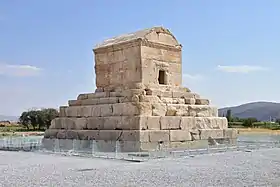Reza Shah's mausoleum
Reza Shah's Mausoleum (Persian: آرامگاه رضا شاه), located in Ray south of Tehran, was the burial ground of Reza Shah Pahlavi (1878–1944), the penultimate Shahanshah (Emperor) of Iran. It was built close to Shah-Abdol-Azim shrine.
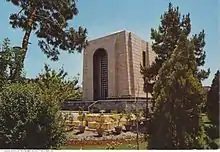 | |
| Coordinates | 35°35′09″N 51°26′03″E |
|---|---|
| Location | Ray, Tehran, Iran |
| Designer | Mohsen Foroughi Keyqobad Zafar Ali Sadeq |
| Type | Mausoleum, Museum (now Religious school) |
| Beginning date | 1948 |
| Completion date | 1950 |
| Opening date | 7 May 1951 |
| Dedicated to | Reza Shah |
| Dismantled date | April–May 1980 |
In addition to Reza Shah, his son, Prince Ali Reza Pahlavi I, is also buried here. The prince who was Mohammad Reza Shah's only full brother, was a pilot and crashed in the Alborz Mountains on October 17, 1954. When the Mausoleum was destroyed, no one found the prince's body.
In the early days of the Iranian Revolution in April 1980, Reza Shah's Mausoleum was destroyed under the direction of Ayatollah Sadegh Khalkhali by Revolutionary Guards; In his memoirs, Khalkhali describes how difficult it was to destroy the building due to its solid structure. Revolutionaries were unable to find Reza Shah's dead body and suggested that Mohammad Reza Shah had taken it with him while leaving Iran, a claim which was denied by Her Imperial Majesty Shahbanu Farah Pahlavi in an interview. On April 23, 2018, a mummified body, possibly that of Reza Shah, was found during expansion work at Shah Abdolazim Shrine at the site of the former mausoleum.[1]
Construction
The construction of the mausoleum began in 1948. The engineers were Mohsen Foroughi, son of Mohammad Ali Foroughi, Keyqobad Zafar and Ali Sadeq, pioneers of modern architecture in Iran. In March 1950, the work was finished.
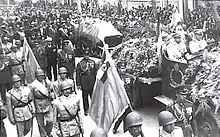
Funeral
The coffin of Reza Shah was brought back from the Kingdom of Egypt by train and then by aeroplane, making two stops, one in Mecca and the other in Medina. Then, later, his body was transferred by plane to Ahvaz, and then later by train to Tehran.
On May 8, 1951, Reza Shah's Imperial funeral took place in Ray, in which Mohammad Reza Pahlavi, the then Shahanshah (Emperor), along with the entire Pahlavi family, many ministers and Prime Minister Mohammad Mossadegh, participated.
Design
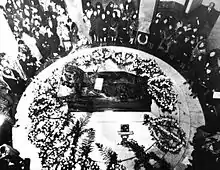
Internal
The mausoleum and its surroundings stretched over an area of 9,000 square metres, and was 25 metres high (without the cupola on the top), that is to say, its height was 7 metres shorter than the dome of the neighbouring Shah Abdolazim Mosque. The architectural style was inspired by the tomb of Les Invalides in Paris, where Napoléon rests.
Inside, a circular colonnade delineated galleries and the centre of the mausoleum, where Reza Shah's sarcophagus, in Izmir blue marble, stood, beside which stood a white marble bust of Reza Shah, and a copy of the Qur'an.
External
The mausoleum had two entrances: one opening directly onto the courtyard of the Shah Abdolazim Mosque, the other one onto a small park enclosed by a wall. A few years later, probably in the 1970s, just before the golden jubilee of the Pahlavi dynasty, the wall was felled (or expanded), the small park was replaced by two large basins in the L-shape identifying the passage leading to the mausoleum, and a large avenue was led through all of Rey in the continuity of the passage leading to the mausoleum.
History
Under Mohammad Reza Shah
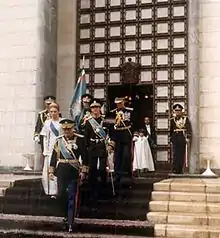
Other people who buried in the mausoleum after 1951 were the assassinated Prime Minister Haj Ali Razmara, Reza Shah's valet Soleyman Behboudi, Prince Ali-Reza Pahlavi, who died in a plane crash in 1954, General Fazlollah Zahedi, a former Prime Minister of Iran, and assassinated Prime Minister Hassan Ali Mansour.
The mausoleum was also a place of visitation for foreign heads of state who came to Iran. Among the foreign dignitaries who visited the mausoleum were Queen Elizabeth II of the United Kingdom, in 1961, and by Emperor Haile Selassie I of Ethiopia, also in the 1960s. During the visit of US President Richard Nixon in 1972 in the mausoleum, a bomb was planted by the terrorist organisation People's Mujaheden, which exploded an hour after the visit of President.
The mausoleum was the scene of several celebrations: the most spectacular being the golden jubilee of the Pahlavi dynasty in 1976, 50 years after the coronation of Reza Shah. Another celebration was held, while the troubles that will lead to the Iranian revolution were already beginning, on March 15, 1978, for the centenary of Reza Shah, at the same mausoleum.
Destruction
After the seizure of power by the Islamic revolutionaries on 11 February 1979, and the fall of Shapour Bakhtiar, the revolution triumphed and Khomeini and his followers settled permanently in power. The Ayatollah sought to erase by all means the remnants of the Pahlavi dynasty, and so ordered the destruction of the mausoleum, supervised by Ayatollah Sadegh Khalkhali.[2]
Sadegh Ghotbzadeh and Abdolhassan Banisadr opposed the destruction of the mausoleum, wanting to make it a "museum of the martyrs of the Pahlavi regime", but this was refused by Khomeini and Khalkhali.
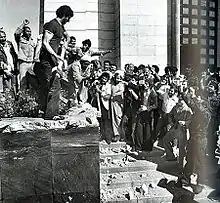
The destruction lasted about twenty days, from April to May 1980. Ayatollah Khalkhali explained his rationale for the destruction by stating:
"He murdered many people, including the Goharshad Mosque, because of their belief in Islam. And the people, as the people of Rey can not bear the thought that the body of such a man is so close to the mausoleum of Shah Abdol-Azim".
It is said that when they told Mohammad Reza Shah (when he was in exile in Cairo) that Reza Shah's Mausoleum was destroyed due to orders from the new Islamic regime, the Shah fell to the floor and was taken to hospital.
Rumors about Reza Shah's dead body
It is commonly believed that when the revolutionaries opened Reza Shah's sarcophagus, they found nothing because Mohammad Reza Shah had his father's body moved elsewhere, probably because the body of the penultimate Shah of Iran is now also at the Al-Rifa'i Mosque with the remains of his son.
But in the documentary of 2015 From Tehran to Cairo, centered on the exile of the Shah in January 1979 to his death in July 1980, his widow, Empress Farah, faces a moment to images of Khalkhali gloating amid ruins of the mausoleum, yet says this:
"The story goes that the government had time to recover the body of Reza Shah the Great to put it somewhere else, hidden ... but it is not; he is still buried there".
"But what did she mean? Has the body been destroyed? Or placed in the mausoleum of neighboring Shah Abdolazim? And what have become of the other bodies present in the mausoleum? Have they been transferred too, as indicated by some sources?", she added
In their biography of the Shah, Houchang Nahavandi and Yves Bomati say that the body of Reza Shah was actually moved before the revolution, but in a secret place still today, known by few people. Shortly before his death on July 27, 1980 (36 years and 1 day after his father), Mohammad Reza Shah told a small circle of intimates a location in Iran where, if his remains were to come back someday, he would like to be buried with soldiers and officers tortured by the revolutionaries; the authors imply that this place could be the same as that where the body of Reza Shah is hidden.
Dead body found
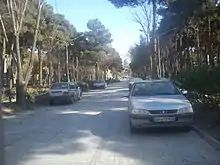
Construction workers in southern Tehran may have stumbled across the mummified body of Reza Shah.[3]
Builders were carrying out construction work at a Shia shrine in Tehran when they found the body amid a pile of rubble.
Hassan Khalilabadi, the head of Tehran's heritage committee, said it was "a possibility" that the corpse may be that of the former Iranian leader. "This will be examined by responsible bodies," he said.
If the body found in Tehran is indeed that of Reza Shah Pahlavi, Iran's current rulers may have a delicate task figuring out what to do with it. Islamic custom demands that all bodies be treated with respect but Iranian authorities will also be wary of allowing it to become a rallying point for opposition groups.
A spokesman for the Shah Abdolazim shrine said the body was not Pahlavi's. "All the rumours on the social media that claim this mummified body belongs to Reza Shah are false and void of any truth," he said.
Pahlavi's grandson, Reza Pahlavi, said in a statement that he was closely following the reports that his grandfather's body had been found. He warned Iran's government "against any secrecy or lack of transparency" in its handling of the body.
Iranian authorities said the body had been reburied. It was not immediately clear what steps Iran planned to take to verify if the body did belong to Pahlavi. A widely shared photograph on social media appeared to show an Iranian construction work taking a selfie with the body after discovering it at the foot of his bulldozer.
Gallery
 Under construction
Under construction Under construction
Under construction A stamp with mausoleum image
A stamp with mausoleum image In the 1960s
In the 1960s In the 1970s
In the 1970s Juliana of the Netherlands visiting the mausoleum
Juliana of the Netherlands visiting the mausoleum Reza Shah's 100th birthday celebrations at the mausoleum
Reza Shah's 100th birthday celebrations at the mausoleum Destroying the Mausoleum
Destroying the Mausoleum
See also
- Houchang Nahavandi et Yves Bomati, Mohammad Réza Pahlavi, le dernier shah 1919-1980, Paris, Perrin, coll. « Biographies », 2013 (ISBN 978-2-262-03587-7, OCLC 828407890)
- Reza Shah
- Sadegh Khalkhali
- Al-Rifa'i Mosque (Mohammad Reza Pahlavi's Mausoleum)
- History of Persian domes
References
- "Mummified body found in Iran could be father of last shah". AP News. Retrieved 2018-04-24.
- SHIRVANI, SHAHRZAD (2018). "Making Histories of "Sacred" Mausoleums: Architectural Representation of Changing Islamic Ideologies". Traditional Dwellings and Settlements Review. 29 (2): 55–71. doi:10.2307/26877323. ISSN 1050-2092.
- "Mysterious mummy found in Iran could be father of last shah". AP NEWS. 2018-04-24. Retrieved 2020-08-14.
